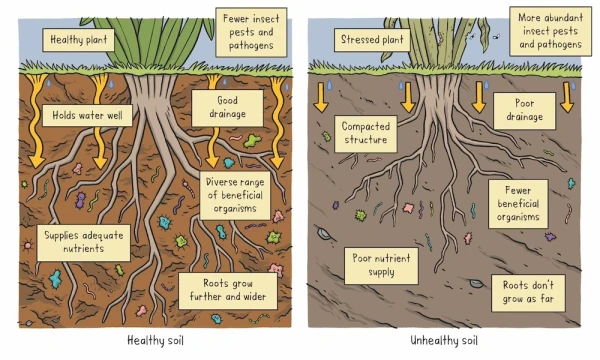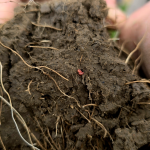Can intensive veggie farming heal the soil? Two years of investigation, visualised
Added one year ago
By Hawke's Bay Future Farming Trust

As published on Spinoff here
Horticulture has largely been left out of regenerative agriculture research in New Zealand. Most of it has focused on beef, lamb and dairy. An on-farm experiment in Gisborne aims to find out if intensive veggie cultivation could heal the soil.
The raised beds of clover stretch in neat rows beneath a crisp winter sky, cloaking half the paddock in lush stripes. The other paddock-half lies fallow, soil laid bare to the elements. This is a science experiment.
On this farm near Gisborne – where your salad greens, sweetcorn, slaw and other veggies are grown – farmers are tinkering with nature’s tools to find the perfect recipe for healthy soil.
It’s part of a multi-year project investigating a different way of growing food, one that could be better for people and the planet.
A farm is a living system and soil is its lifeblood. But across New Zealand, the conventional way we’ve intensively grown veggies has “smashed” the soil, says Matt Norris, scientist at Plant & Food Research.
We’ve churned it up with ploughing and tilling, left it bare and rootless, and allowed wind and water to eat away at our rich topsoil. This has left the soil depleted, running on empty.
In particular, we’ve lost organic carbon on arable land. This carbon is the “glue” that holds the soil together and keeps it functioning like a living organism, Norris explains. If that glue begins to disappear, you run into a bunch of problems. Hard, compacted soil. Nutrient run-off. Fewer beneficial bugs in the soil microbiome.
Gordon McPhail, general manager of farming at LeaderBrand, says the decline in soil health has been challenging. “We don’t shy away from that. We see it in yield, we see it in our soil structure. We see it in runoff or moisture retention,” he says. But they’ve been trying to do better by the soil, and that’s where this new field trial, and regenerative agriculture, come in.
Regenerative agriculture (or regen ag, for short) is a holistic approach to farming that aims to generate positive, sustainable outcomes for nature – richer soils, greater biodiversity and clean freshwater – as well as for animal welfare and rural communities.
There are no hard and fast rules in regen ag. Some see it as a spectrum of sustainable practices – from avoiding pesticides to reducing tilling to planting more diverse crops. Others see it as a mindset that questions the status quo.
For Woolworths, regen ag offered a potentially clear pathway to help their growers lift sustainability. “Focusing on soil as the foundation for food production is really important from a food security perspective,” says Catherine Langabeer, Head of Sustainability at Woolworths. The flexibility of regen ag felt important, she says, by empowering farmers to tailor solutions to their landscape, climate and farm needs.
Most of New Zealand’s regen ag research has focused on beef, lamb and dairy. Horticulture has been a blind spot. To fill this gap, Woolworths jointly developed a research plan, in partnership with veggie growers at LeaderBrand and science experts from Plant & Food Research, and funding from the Ministry for Primary Industries’ Sustainable Food and Fibre Futures Fund.
So, can you grow veggies intensively and heal the soil at the same time? The key might lie with becoming not just veggies farmers, but microbe farmers.

There’s a cornucopia of ways you can try to reinvigorate soil. But for this experiment, LeaderBrand chose two.
The first soil-boosting intervention: cover crops. These are plants grown after your main crop or “cash crop” is harvested. Cash crops are corn, wheat, tomatoes, anything grown for its commercial value. Post-harvest, cover crops protect the soil. Their roots prevent erosion and make the soil more sponge-like. Cover crops also help mop up excess nutrients in the soil. Eventually, instead of harvesting, cover crops are ploughed down and incorporated back into the earth. This helps build soil carbon and feed the hungry soil microbes which will help the cash crop’s next season along. “It’s a bit like gut health in humans,” says Norris. Plant & Food Research scientists developed a menu of cover crops best suited to the Gisborne farm’s seasonal growing schedule, climate and soil characteristics.
The science team also used laboratory experiments to test the effects of the farm’s stockpiled compost on soil nutrients – the nitrogen, phosphorus and other elements plants need to grow. Compost alone didn’t provide a big enough nitrogen hit to meet most commercial crops’ needs – you’d still need to apply fertiliser, they concluded. But over time, with repeated compost applications, nutrient cycling would rev up, and need for fertiliser would reduce – at least theoretically, Norris says.
A third research strand – not focused on soil – investigated what natives LeaderBrand could plant as part of a wetland restoration project. If planting choices aren’t carefully thought through, you risk introducing the perfect habitat for pests that eat adjacent crops. But you can also select natives that will boost the population of farmer-friendly insects – a.k.a. “natural enemies” who keep pest numbers in check.
The second phase of the project put compost and cover crops to the test over sow-grow-harvest cycles. Two sites were picked – one for summer crops, and one for winter – each site was divided into a ‘standard’ zone and a ‘regenerative’ zone.
At the winter site, baby leaf spinach and mesclun were grown over the cooler months. In the regenerative zone, compost was applied before sowing, and then again after the last of the salad greens had been harvested. Following this, a cover crop of sorghum blanketed the soil for four months of summer. In the standard zone, it was business as usual: no compost, and no long-term cover crop. Both zones received fertiliser.
At the summer site, sweetcorn was the crop of choice. In the regenerative zone, compost was applied once before the corn went in. Following harvest, a cover crop of intermingled ryegrass, clover and vetch cloaked the field for winter. In the standard plot: no compost, and no cover crop – just bare soil. Both regenerative and standard zones received fertiliser.
As the seasons shifted and the sow-grow-harvest cycle wheeled along, the science team performed regular soil health and fertility check-ups. They observed little difference between the regen and standard zone soils when it came to most measures – results that were “not unexpected,” says Norris. “It’s still early days. It can be a five-to-ten year process to see meaningful shifts.”
But there was one soil health indicator that shot up: in the regen zones, it appeared as though the soil microbes were having a party, feasting on the residual plant matter. The unharvested cover crops, ploughed back into the field, provided a carbon-snack that allowed the microbes to proliferate. Compost, too, can provide fuel for soil bugs – but the carbon in compost is generally less accessible for soil microbes and hangs around for a longer time period. The cover crops provide the equivalent of a sugary snack to jumpstart microbial life.
Two regeneratively grown winter salad leaf crops saw bumps in yield – a positive result that Norris chalks up to compost improving the soil structure, allowing the plants’ roots to more easily draw up nutrients.
But the sweetcorn yield dipped substantially in the regen zone, and the Plant & Food Research team are still working through why that might be. Their current working theory is that there was some component of the compost that inhibited the sweetcorn’s growth.

Seeing how science-informed regen ag practices can work practically, on-farm has been a key takeaway, says McPhail. He’s looking beyond the three-year trial – after all, “the natural ecosystem takes time to repair and balance itself out,” he says. “We need to be patient in that sense. And there’s also the fact that no two years are the same.” The first half of 2023, as the year two trial got underway, was particularly rough for Gisborne: Cyclone Gabrielle, and a prolonged soddenness.
Alongside the hard science, the project is exploring the people side of things: what do farmers, LeaderBrand team, iwi and the wider community make of this whole regen ag thing? A survey revealed “a range of views,” says McPhail, but with an overall positive vibe. It’s fired him up about connecting people, making them feel part of the journey, telling the story of what they do.
A research platform like this, enabling farmers to “test stuff out,” is a “conversation starter,” says Norris – but one that is often not available, as funders shy away from risk.
Stepping up to this risk has offered Langabeer and the Woolworths team valuable insight into how to strengthen their long-term relationships with their growers. Growers still have to supply food, as well as innovating. It’s not an easy task. “Change won’t happen overnight. Insights and trends take time to emerge,” she says. “That is why studies like this are so very important, you need partnerships in the food industry that are prepared to sustain these longer term projects.”
Food production, according to Langabeer, is an area ripe with hope for positive environmental and climate action. “We have a challenge, but we also have an opportunity,” she says. It’s low-hanging fruit – or in this case, easy-to-pick veggies.
Join the conversation
Be the first to leave a comment.
Leave a comment
All comments are reviewed before they are published on the website. Your email address will not be published.



Community Engagement and Knowledge Sharing Strengthen the Carbon Positive Project


Farewell to Trustee Phil Schofield – A Foundational Leader of the HBFFCT

